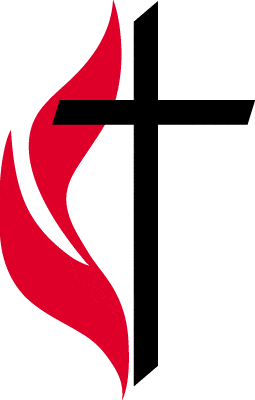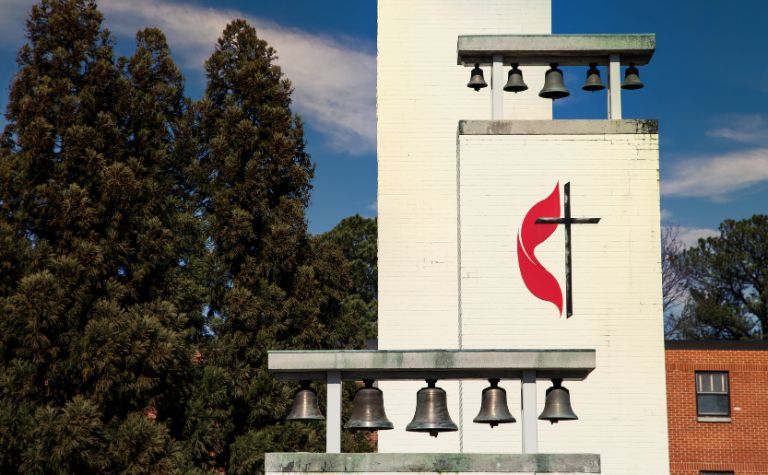Methodism is an important and influential branch of Protestant Christianity. The tradition, founded by John Wesley (1703-1791) in 18th century England, has traditionally upheld the primary doctrines of the Christian faith, like the Trinity, the inspiration of Scripture, and the resurrection of Jesus Christ. However, it has also focused on ministries that promote evangelism and discipleship and serve those in need.
What many people know as the symbol of Methodism — the cross and flame — is the symbol of one Methodist denomination, the United Methodist Church. With over 7 million members, the UMC is the largest Methodist denomination in the world and the second largest in America.
When Christian denominations and churches use symbols, they visually depict beliefs and values that characterize their institution. Shapes, colors, and designs can communicate in ways that words sometimes can’t. Below you will find interesting information about the cross and flame symbol, including why some are ready to replace it.

When Was the Cross and Flame Symbol Adopted?
The cross and flame symbol doesn’t date to the time of John Wesley but to the mid-20th century. The symbol marked the merger of The Methodist Church and the Evangelical United Brethren Church, which created the United Methodist Church. (Also see Why Do Methodist Churches Change Pastors?)
The merger occurred in 1968 when the UMC created and adopted the cross and flame symbol. Denominational leaders considered over two dozen designs before leaders selected the winner.
Edward J. Mikula, the art director, and Edwin H. Maynard, the editorial director, oversaw the project. The flames in the symbol have a double meaning.
- First, the flames depict truths found in Scripture (see below).
- Second, the flames represent the newly-formed relationship between The Methodist Church and the Evangelical United Brethren Church.
What Does the Cross Symbolize to Methodists?
The “cross and flame” depict the life and ministry of Jesus Christ and the Holy Spirit, respectively. Like other Christians, Methodists believe Christ died on the cross as a substitute for sinners and a penalty for their sins. (Also see Do Methodists Drink Alcohol?)
Concerning the flame, the Bible sometimes depicts Holy Spirit with the imagery of fire and flames, such as at Pentecost. [1]
Verses about the cross of Christ:
- 1 Corinthians 1:18, “For the word of the cross is folly to those who are perishing, but to us who are being saved it is the power of God.” (ESV)
- Romans 5:8, “But God shows his love for us in that while we were still sinners, Christ died for us.” (ESV)
- Colossians 2:14, “By canceling the record of debt that stood against us with its legal demands. This he set aside, nailing it to the cross.” (ESV)
Verses about the Holy Spirit being like fire:
- Acts 2:3, “And divided tongues as of fire appeared to them and rested on each one of them.” (ESV)
- Matthew 3:11, “I baptize you with water for repentance, but he who is coming after me is mightier than I, whose sandals I am not worthy to carry. He will baptize you with the Holy Spirit and fire.” (ESV)
- Hebrews 12:29, “For our God is a consuming fire.” (ESV)

Does the Cross Symbol Have Anything To Do With John Wesley?
The conversion of John Wesley is foundational to the Methodist tradition, and elements of his story characterize the movement. He preached and wrote extensively, and people can read an abundance of literature today to learn about his life and convictions, including the personal journals he kept. (Also see Do Methodists Speak in Tongues?)
In one journal entry, reflecting on his conversion, Wesley writes of being “strangely warmed” through the gospel, “In the evening I went very unwillingly to a society in Aldersgate Street, where one was reading Luther’s preface to the Epistle to the Romans.”
He continues, “About a quarter before nine, while he was describing the change which God works in the heart through faith in Christ, I felt my heart strangely warmed. I felt I did trust in Christ, Christ alone, for salvation; and an assurance was given me that He had taken away my sins, even mine, and saved me from the law of sin and death.” [2]
The cross and flame symbol make some Methodists think of Wesley’s conversion to Christ and the origin of their tradition. (Also see Do Methodist Churches Have Women Pastors?)
How Is the Cross Symbol Used In Methodism?
It’s common to find the cross and flame symbol on UMC church signs and in the literature the denomination publishes.
Originally, UMC leaders wanted people to think of their denomination when they saw the cross and flame symbol. Their branding efforts were generally successful, as many people think of Methodism when they see the symbol. As a result, the UMC trademarked the symbol in 1971. (Also see Do Methodists Wear Crosses?)

Why Do Some Methodists Want To Replace the Cross and Flame?
Some leaders and members of the UMC have discussed replacing the cross and flame symbol with another yet-to-be-determined image. (Also see Methodist vs. Catholic: What’s the Difference?)
Some in the denomination believe that the image unintentionally, but unfortunately, depicts a burning cross. In American history, racist groups like the Ku Klux Klan burned crosses to intimidate African-American people.
In an article titled “Time for the Cross and Flame To Go,” UMC pastor, Edlen Cowley, writes, “When I saw the United Methodist Cross and Flame, I didn’t think of John Wesley’s heart being strangely warmed, I didn’t think of the flaming tongues of fire resting on the Apostles in Acts 2.”
He continues, “I didn’t think of how each tongue of the flame represents the former denominations that came together to form The United Methodist Church — The Evangelical United Brethren and The Methodist Church. My mind went back to that burning cross I saw on the side of the freeway — a symbol my mother told me was devised to cause fear in black people.” [3]
Cowley expresses great respect for the history of the denomination he serves. He acknowledges that the designers of the cross and flame intended to convey biblical imagery and unity within Methodism, “I respect and honor the creative process that Edward J. Mikula and Edwin H. Maynard went through when they designed the insignia that would debut in 1968.”
He continues, “I honor the cross and the two tongues of flame, that each represents the two denominations that came together. I honor the Acts 2 Pentecostal Flame that also gives representation to Wesley’s heart being strangely warmed. [3]
However, the connotation the cross and flame have for African-American people is too much to overcome. According to Cowley, “It is time for open and serious discussion and a clear and liberating decision about the banner under which all United Methodists stand. It is time to move on from the Cross and Flame.” [3]
References:
[1] Source
[2] Source
[3] Source
Related Questions
Methodism and Anglicanism are distinct branches of Christianity, though they have a closer relationship to each other than to other denominations and traditions. Because of their unique connection,...
The Methodist Church and the Roman Catholic Church both value doctrine and practice. Both traditions also believe they faithfully follow the teachings of Jesus of Nazareth, and they agree on...
